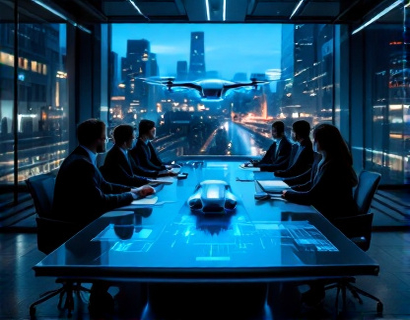Next-Gen Aerospace Innovations: Transforming Efficiency and Safety for Industry Leaders
The aerospace industry stands at the precipice of a technological revolution, driven by innovations that promise to redefine efficiency and safety in aviation and space exploration. As industry leaders and visionaries look to the future, it is essential to understand the advancements that are shaping the landscape of aerospace engineering. This article delves into the latest technological breakthroughs, exploring how they are transforming the industry and paving the way for a safer, more efficient future.
1. The Rise of Autonomous Systems
One of the most significant advancements in aerospace technology is the development of autonomous systems. These systems leverage artificial intelligence (AI) and machine learning to enhance decision-making processes, reduce human error, and improve operational efficiency. Autonomous drones and aircraft are being tested and deployed for various applications, including cargo delivery, surveillance, and even passenger transport.
For instance, companies are developing unmanned aerial vehicles (UAVs) that can operate without human intervention, navigating complex environments and adapting to changing conditions in real-time. This technology not only increases efficiency but also enhances safety by minimizing the risk of accidents caused by human error.
2. Advanced Materials and Manufacturing Techniques
The aerospace industry is also witnessing a shift towards advanced materials and manufacturing techniques that enhance performance while reducing weight and costs. Innovations such as additive manufacturing, commonly known as 3D printing, allow for the creation of complex components with reduced material waste and shorter production times.
Lightweight materials, such as carbon fiber composites and titanium alloys, are being utilized to construct aircraft that are not only more fuel-efficient but also have improved structural integrity. These materials contribute to lower operational costs and reduced environmental impact, aligning with the industry's push towards sustainability.
3. Sustainable Aviation Fuel (SAF)
As the world grapples with climate change, the aerospace industry is actively seeking sustainable solutions to reduce its carbon footprint. Sustainable aviation fuel (SAF) is emerging as a viable alternative to traditional jet fuel, derived from renewable resources such as plant materials and waste products.
SAF can significantly reduce greenhouse gas emissions, making it a crucial component of the industry's sustainability strategy. Major airlines and manufacturers are investing in research and partnerships to scale up the production and use of SAF, aiming to achieve net-zero emissions by 2050.
4. Enhanced Safety Protocols through Data Analytics
Data analytics is playing a pivotal role in enhancing safety protocols within the aerospace sector. By harnessing big data, companies can analyze vast amounts of information from various sources, including flight data, maintenance records, and weather patterns. This analysis enables predictive maintenance, allowing for timely interventions before potential failures occur.
Furthermore, data-driven insights can improve pilot training programs, ensuring that crews are better prepared to handle emergencies. The integration of data analytics into safety protocols not only enhances operational safety but also fosters a culture of continuous improvement within organizations.
5. Next-Generation Air Traffic Management
The increasing volume of air traffic necessitates a rethinking of air traffic management systems. Next-generation air traffic management (ATM) solutions leverage advanced technologies such as satellite-based navigation and real-time data sharing to optimize flight paths and reduce congestion.
These systems enhance situational awareness for air traffic controllers and pilots, leading to more efficient flight operations. By minimizing delays and improving the flow of air traffic, next-gen ATM solutions contribute to reduced fuel consumption and lower emissions, aligning with the industry's sustainability goals.
6. Space Exploration Innovations
The advancements in aerospace technology are not limited to aviation; they are also revolutionizing space exploration. The development of reusable launch vehicles, such as SpaceX's Falcon 9, has drastically reduced the cost of accessing space. This innovation allows for more frequent launches and opens up new possibilities for scientific research and commercial ventures in space.
Moreover, advancements in propulsion systems, such as ion propulsion and nuclear thermal propulsion, are being explored to enable faster and more efficient travel to distant destinations, including Mars and beyond. These innovations are crucial for the future of space exploration, making ambitious missions more feasible and sustainable.
7. Cybersecurity in Aerospace
As aerospace systems become increasingly interconnected, cybersecurity has emerged as a critical concern. The potential for cyber threats to compromise safety and operational integrity necessitates robust cybersecurity measures. Aerospace companies are investing in advanced security protocols to protect their systems from cyberattacks.
Implementing multi-layered security frameworks, continuous monitoring, and incident response strategies are essential to safeguarding sensitive data and ensuring the safety of aircraft and space vehicles. As the industry evolves, prioritizing cybersecurity will be paramount to maintaining trust and safety in aerospace operations.
8. The Role of Simulation and Virtual Reality
Simulation and virtual reality (VR) technologies are transforming training and development within the aerospace sector. These tools provide immersive training experiences for pilots, engineers, and maintenance personnel, allowing them to practice and refine their skills in a safe environment.
By simulating real-world scenarios, trainees can gain valuable experience without the risks associated with actual flight or maintenance operations. Additionally, VR can be used for design and prototyping, enabling engineers to visualize and test new concepts before physical production, thus streamlining the development process.
9. Collaborative Robotics in Manufacturing
The integration of collaborative robotics, or cobots, into aerospace manufacturing processes is enhancing efficiency and precision. These robots work alongside human operators, assisting with tasks such as assembly, inspection, and quality control. By automating repetitive and labor-intensive tasks, cobots free up human workers to focus on more complex and value-added activities.
This collaboration not only improves productivity but also enhances safety by reducing the risk of workplace injuries. As the demand for aerospace products continues to grow, the adoption of collaborative robotics will be crucial in meeting production targets while maintaining high standards of quality and safety.
10. The Future of Aerospace Engineering
As we look to the future, the aerospace industry is poised for unprecedented growth and innovation. The convergence of various technologies, including AI, advanced materials, and sustainable practices, will continue to drive advancements in efficiency and safety. Industry leaders must remain agile and adaptable, embracing these innovations to stay competitive in a rapidly evolving landscape.
Collaboration between industry stakeholders, including manufacturers, regulators, and research institutions, will be essential in fostering a culture of innovation. By sharing knowledge and resources, the aerospace community can accelerate the development and implementation of next-gen technologies that will shape the future of aviation and space exploration.
Conclusion
The next generation of aerospace innovations is transforming the industry, enhancing efficiency and safety in ways previously thought impossible. From autonomous systems and advanced materials to sustainable aviation fuels and enhanced safety protocols, these technological advancements are paving the way for a brighter future in aerospace engineering. As industry professionals and visionaries embrace these changes, the potential for growth and improvement in aviation and space exploration is limitless. The journey ahead is one of collaboration, innovation, and a commitment to pushing the boundaries of what is possible in aerospace technology.










































